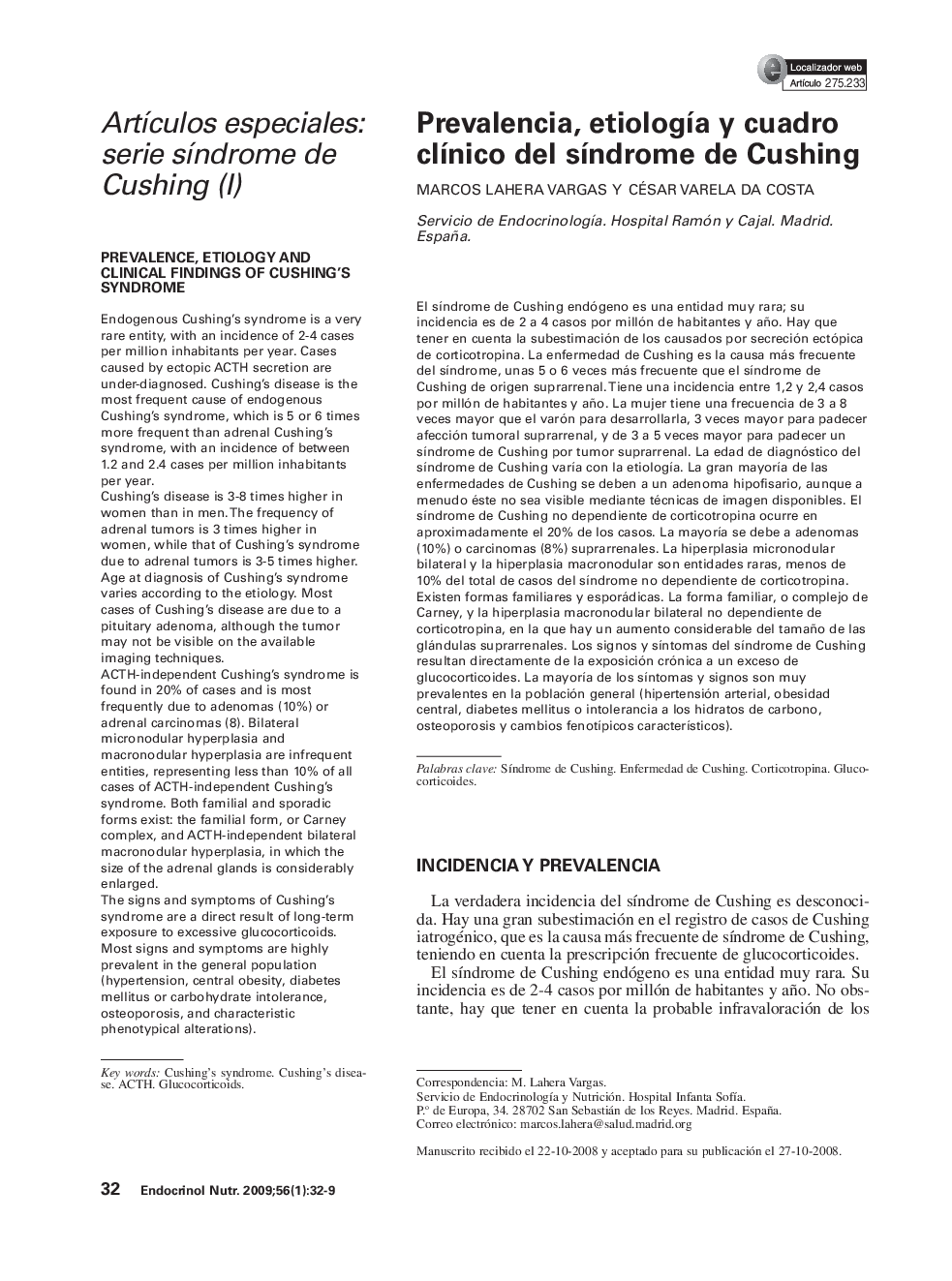| کد مقاله | کد نشریه | سال انتشار | مقاله انگلیسی | نسخه تمام متن |
|---|---|---|---|---|
| 2774468 | 1152215 | 2009 | 8 صفحه PDF | دانلود رایگان |

El síndrome de Cushing endógeno es una entidad muy rara; su incidencia es de 2 a 4 casos por millón de habitantes y año. Hay que tener en cuenta la subestimación de los causados por secreción ectópica de corticotropina. La enfermedad de Cushing es la causa más frecuente del síndrome, unas 5 o 6 veces más frecuente que el síndrome de Cushing de origen suprarrenal. Tiene una incidencia entre 1,2 y 2,4 casos por millón de habitantes y año. La mujer tiene una frecuencia de 3 a 8 veces mayor que el varón para desarrollarla, 3 veces mayor para padecer afección tumoral suprarrenal, y de 3 a 5 veces mayor para padecer un síndrome de Cushing por tumor suprarrenal. La edad de diagnóstico del síndrome de Cushing varía con la etiología. La gran mayoría de las enfermedades de Cushing se deben a un adenoma hipofisario, aunque a menudo éste no sea visible mediante técnicas de imagen disponibles. El síndrome de Cushing no dependiente de corticotropina ocurre en aproximadamente el 20% de los casos. La mayoría se debe a adenomas (10%) o carcinomas (8%) suprarrenales. La hiperplasia micronodular bilateral y la hiperplasia macronodular son entidades raras, menos de 10% del total de casos del síndrome no dependiente de corticotropina. Existen formas familiares y esporádicas. La forma familiar, o complejo de Carney, y la hiperplasia macronodular bilateral no dependiente de corticotropina, en la que hay un aumento considerable del tamaño de las glándulas suprarrenales. Los signos y síntomas del síndrome de Cushing resultan directamente de la exposición crónica a un exceso de glucocorticoides. La mayoría de los síntomas y signos son muy prevalentes en la población general (hipertensión arterial, obesidad central, diabetes mellitus o intolerancia a los hidratos de carbono, osteoporosis y cambios fenotípicos característicos).
Endogenous Cushing's syndrome is a very rare entity, with an incidence of 2-4 cases per million inhabitants per year. Cases caused by ectopic ACTH secretion are under-diagnosed. Cushing's disease is the most frequent cause of endogenous Cushing's syndrome, which is 5 or 6 times more frequent than adrenal Cushing's syndrome, with an incidence of between 1.2 and 2.4 cases per million inhabitants per year.Cushing's disease is 3-8 times higher in women than in men. The frequency of adrenal tumors is 3 times higher in women, while that of Cushing's syndrome due to adrenal tumors is 3-5 times higher. Age at diagnosis of Cushing's syndrome varies according to the etiology. Most cases of Cushing's disease are due to a pituitary adenoma, although the tumor may not be visible on the available imaging techniques.ACTH-independent Cushing's syndrome is found in 20% of cases and is most frequently due to adenomas (10%) or adrenal carcinomas (8). Bilateral micronodular hyperplasia and macronodular hyperplasia are infrequent entities, representing less than 10% of all cases of ACTH-independent Cushing's syndrome. Both familial and sporadic forms exist: the familial form, or Carney complex, and ACTH-independent bilateral macronodular hyperplasia, in which the size of the adrenal glands is considerably enlarged.The signs and symptoms of Cushing's syndrome are a direct result of long-term exposure to excessive glucocorticoids. Most signs and symptoms are highly prevalent in the general population (hypertension, central obesity, diabetes mellitus or carbohydrate intolerance, osteoporosis, and characteristic phenotypical alterations).
Journal: Endocrinología y Nutrición - Volume 56, Issue 1, January 2009, Pages 32–39